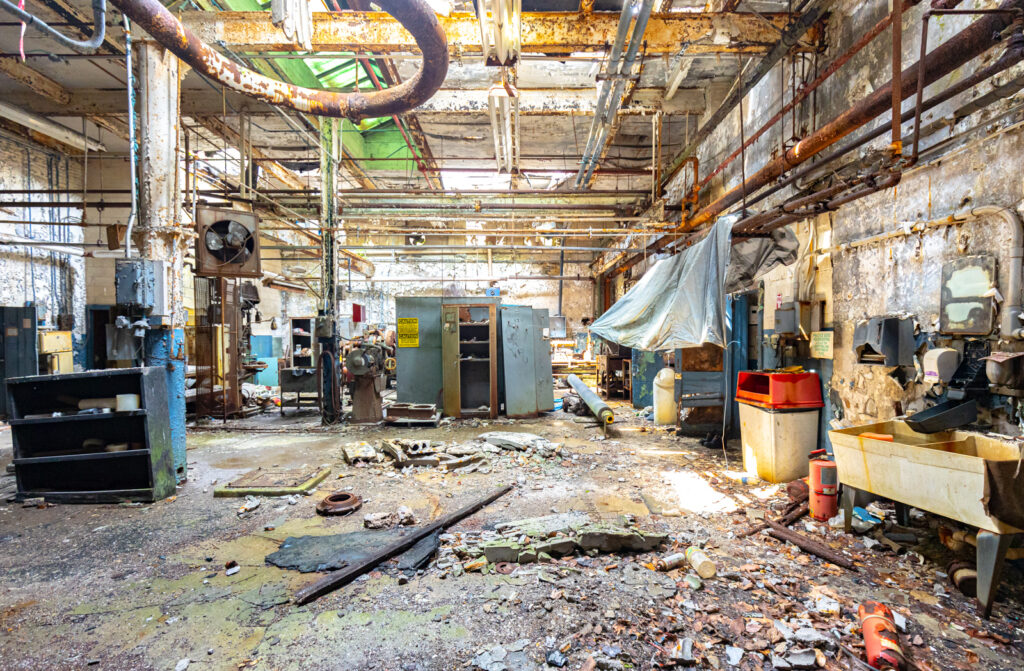
Abandoned Paper Mill in New Jersey
Before I get started, just a quick note that locations, names, and other identifiable information will be left out as much as possible. While this abandoned paper mill has sat unused for many years, it’s still in good shape, and has not been ravaged by scrappers or vandals. My hope is that it stays that way for others to explore.
Originally built in the early 1900’s by Riegal Paper Company, this former mill changed hands, and names multiple times throughout the years. Unfortunately this isn’t much documented material on what the plant originally specialized in.
Fast forward to the early 1970s. Around this time, the facility, along with two other nearby facilities, was acquired by the Jame River Paper Company, which at the time was one of (if not the) largest paper corporations in the world. Even bigger than Dunder Mifflin. The James River Company would then lease the facility to a subsidiary of another company. Part of the agreement included the Jame River Company constructing a landfill. The landfill would collect the runoff and “leachate” water, sending it back to the facility’s treatment section. It would then be treated and safely sent back into the nearby river. Four years later, the paper mill was sold, and the landfill was sold to a separate company. At the time, both companies agreed to continue the process that was in place between the paper mill and the landfill. This would eventually not happen as the company who purchased the landfill would stop accepting the plant’s waste just a few years later.
The company would see more changes over the upcoming years, including internal restructuring, and being renamed. Additionally, in the late 90’s, it was announced that one of the three plants would be closed. However, the company planned to make major investments in equipment at this location, in excess of $15 million. Just a few short years later, the company would file for bankruptcy, and plan to close the remaining open facilities.
Contamination and Cleanup
This is the part that gets a little murky.
In the early 2000’s, the company that purchased and controlled the landfill, planned to file for bankruptcy and abandoned the landfill. As part of the plan, they reached an agreement with the New Jersey Department of Environmental Protection (DEP). The company would agree to paying roughly $1 million for cleanup of the landfill.
Even with the hopes and promises that. the new expensive machinery would help the company compete with the Chinese paper company competitors, the company was still losing money. The parent company in turn filed for bankruptcy in 2004. At that time, they also filed motions that they no longer be responsible for the agreement to maintain the runoff of the landfill. That motion was successful, and passed.
Two years later, it was formally announced that the paper mill would be closed. The DEP was was still obligated to manage the landfill and began researching what to with the property. They tried to sell the property, but the runoff from the landfill proved to make it almost impossible. Enter the murkiness. It’s reported that the company issued a letter to the DEP explaining that the plant would be closed and that the would need to stop the runoff from the plant. The DEP reportedly ignored this letter, as well as all the follow up requests from the company on this issue. It wasn’t until several months later, after the DEP finished their assessment of the landfill, that they responded. It essentially came down to the DEP passing the buck, saying they did not have an alternative way to treat the water, and that it would fall back to the responsibility of the company (even though the company had already been legally released from any obligations). This would lead to many months of fighting and arguing between the company and the DEP.
I won’t bore you with more legal talk, but the company would eventually file restraining orders against the DEP to stop further contamination, as well as lawsuits. Despite witnesses and witness testimony backing up the company’s claims, the judge eventually sided with DEP and the company lost the case. This was their last hope, and the end of the road for the paper mill
